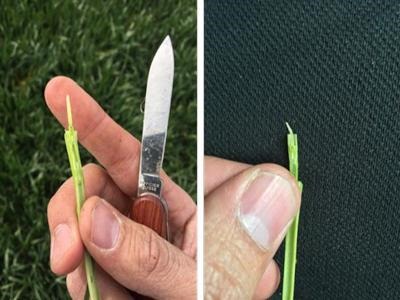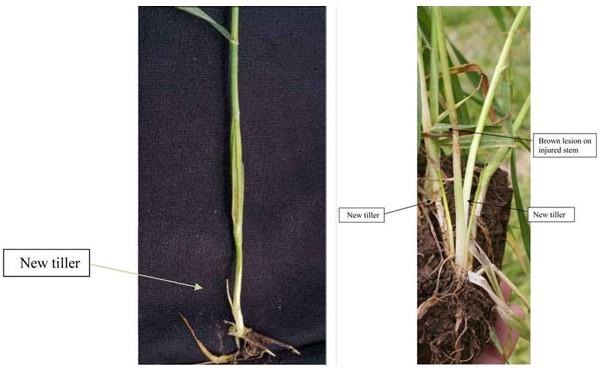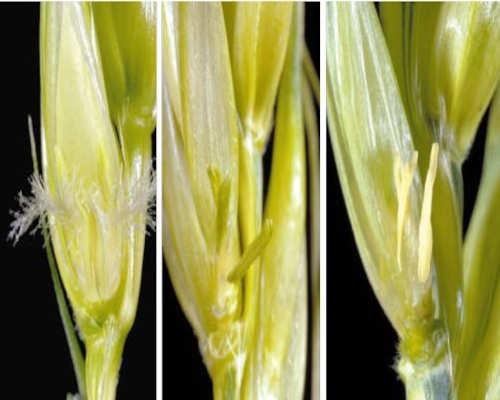By Romulo Lollato
The recent cold temperatures experienced this week (April 20-22, 2021) were enough to cause freeze damage to Kansas wheat. The actual freeze damage will be region-specific depending on crop growth stage and minimum temperatures (some regions had a worst combination of temperatures and crop growth stage). Additionally, the degree of injury within a region will be field-specific, owing to many individual aspects such as crop density, residue level, etc.
While there is nothing that can be done immediately, growers can prioritize fields where they sample for freeze damage symptoms depending on conditions that were more likely to result in freeze damage. This article provides information about these individual conditions that might help growers prioritize fields to be sampled; as well as specific injury symptoms.
Field conditions that can affect the potential for freeze damage
Density of the stand and condition of the plants. If the stand is thick, that will tend to reduce the extent of freeze damage as the warmth of the soil will radiate up into the canopy. On the other hand, well-fertilized, succulent wheat has often sustained more freeze injury than wheat that is not as well fertilized. Thin stands are at higher risk of injury because the air can penetrate the stand more easily. If the plants were wet before the freeze, this can result in a coat of ice on the plants that may protect the growing point to some extent. If temperatures get too low, however, the cold will go through the ice.
Residue. No-till fields can often sustain more freeze damage because the residue acts as a blanket and doesn’t allow the heat from the soil to radiate up into the plant canopy.
Soil moisture. There is often less freeze injury at a given temperature when soils are wet than when dry. Wetter soils tend to radiate a little more warmth than dry soils. On the other hand, drought-stressed plants tend to be more hardened against cold injury and their lower leaf water content tends to decrease the severity of the freeze injury.
Wind speed. Windy conditions during the nighttime hours when temperatures reach their lows will reduce the amount of warmth radiating from the soil and increase the chance of injury.
Temperature gradients within the field (position on the landscape). Low spots in the field are almost always the first to have freeze injury. The coldest air tends to settle in the low areas, especially under calm (no wind) conditions.
Wheat variety. Although the sensitivity to freezing temperatures at a given growth stage is very similar across all varieties, varieties can differ in their release from winter dormancy by as much as three weeks. Because of differences in winter-dormancy release, late-release varieties may escape a freeze injury because they are delayed in their development.
Injury symptoms to look for in the coming days
There are many possible scenarios after a freeze. Producers should not take any immediate action following a freeze event. Several days of warm temperatures are needed to properly assess freeze damage to the wheat crop.
Jointing
Where wheat was at the jointing stage (north central and northwest Kansas), producers should watch their fields closely over the next 7 to 10 days for the following:
- The color of newly emerging leaves. If they are nice and green, that probably indicates the tiller is alive. If newly emerging leaves are yellow, that probably indicates the tiller is dead. The color of existing leaves is not terribly important, except for the flag leaf, which should not have emerged at this point in time yet. Existing leaves will almost always turn bluish-black after a hard freeze, and give off a silage odor. Those leaves are burned back and dead, but that in itself is not a problem as long as newly emerging leaves are green.
- The color of the developing head or growing point in wheat that has jointed. As long as heads are light green, crisp, and turgid, the head in that tiller is fine. If the head is whitish, flaccid, and mushy, it has died (Fig. 1).
- Ice in the stems. If there was ice in the stems below the first node the morning of the freeze, those tillers may be damaged (although not always) and may not produce grain. You may see split stems from ice accumulation.
- Stem integrity. If the wheat lodged immediately after the freeze, that indicates stem damage. Later tillers may eventually cover the damaged tillers. Even if there is no immediate lodging, look for lesions or crimps anywhere on the stems. If these symptoms are present, it usually means the wheat will lodge at some point during the season. If the stems look undamaged, that’s a good sign.

Figure 1. Following an early freeze, wheat at jointing might still develop healthy heads (left panel), but depending on minimum temperatures and duration of the freeze event, the developing head might be killed even if still within the stem (right panel). The dead head is whitish and flaccid while the healthy head is light green and turgid.
The best thing producers can do for the first few days is simply walk the fields to observe lodging, crimped stems, and damaged leaves. Producers should not take any immediate actions as a result of the freeze, such as destroying the field for re-cropping. It will take several days of warm weather to accurately evaluate the extent of damage. After several days, producers should split open some stems and check the developing head.
Where stems and/or growing points were killed by the freeze, new tiller growth (coming from the crown area) will occur (Fig. 2). In many cases, new tiller growth can be observed even when the stems do not show any symptoms of freeze damage for some time. In those cases, the first sign that the tillers are dead is the sudden growth of new tillers at the base of the plant.
If secondary tillers may begin growing normally and fill out the stand, the wheat may look ragged because the main tillers are absent. Producers should scout for bird cherry oat aphids and other potential insect or disease problems on these late-developing tillers. Enough tillers may survive to produce good yields if spring growing conditions are favorable. If both the main and secondary tillers are injured, the field may eventually have large areas that have a yellowish cast and reduced yield potential.
 Figure 2. Left: A stem that was split open by having ice form within the stem. This stem has died and a new tiller has begun to grow at the base. Right: Some of the tillers on this plant had freeze damage to the lower stems. These stems are dying, but the symptoms may not be immediately evident. The growth of new tillers from the base of the plant is a sure sign that the main tillers are dead or dying. Note the brown lesion on the stem with the two new tillers.
Figure 2. Left: A stem that was split open by having ice form within the stem. This stem has died and a new tiller has begun to grow at the base. Right: Some of the tillers on this plant had freeze damage to the lower stems. These stems are dying, but the symptoms may not be immediately evident. The growth of new tillers from the base of the plant is a sure sign that the main tillers are dead or dying. Note the brown lesion on the stem with the two new tillers.
Boot
Some crops in south central Kansas and southeast Kansas might have been at this stage when the freeze happened. At the boot stage, wheat can be injured if temperatures drop down into the mid to upper 20’s for several hours. Injury is more likely if this occurs repeatedly and if it is windy at night. To detect injury, producers should wait several days then split open some stems and look at the developing head. If the head is green or light greenish in color and seems firm, it is most likely going to be fine. If the head is yellowish and mushy, that’s a sign of freeze injury.
Freeze injury at the boot stage causes a number of symptoms when the heads are enclosed in the sheaths of the flag leaves. Freezing may trap the spikes inside the boots so that they cannot emerge normally. When this happens, the spikes will remain in the boots, split out the sides of the boots, or emerge base-first from the boots.
Sometimes heads emerge normally from the boots after freezing, but remain yellow or even white instead of their usual green color. When this happens, all or part of the heads have been killed. Frequently, only the male parts (anthers) of the flowers die because they are more sensitive to low temperatures than the female parts. Since wheat is self-pollinated, sterility caused by freeze injury results in poor kernel set and low grain yield.
It’s possible for some of the spikelets to be alive and be a healthy dark green while other spikelets on the same head are damaged. If a spikelet flowers normally and the kernels on that spikelet develop normally, then the head is at least partially viable and will produce grain (unless it freezes again, of course).
Awns beginning to appear
If the awns have begun to appear, there can be significant injury to the heads if temperatures reach about 30 degrees or lower for several hours. The heads may fully exert from the boot, but few, if any, of the spikelets may pollinate normally and fill grain. Damaged heads from a freeze at this stage of growth may seem green and firm at first glance, but the floral parts will be yellowish and mushy.
Flowering
While the majority of the Kansas wheat fields are not at flowering when temperatures got below freezing on April 22, it is possible that a few fields in southeast Kansas may be in nearing this stage, particularly early-maturing varieties. Wheat is particularly vulnerable to damage from freezing weather as the head starts to emerge through the flowering stage. Temperatures of 30 degrees or lower can damage anthers.
If the wheat was in the flowering stage at the time of the freeze, you can determine if the anthers are damaged by examining them with a magnifying lens. Healthy anthers will first be lime green, then yellow (Figure 3-left). If they are damaged by a freeze, they will begin twisting within 2 to 3 days (Figure 3-center). Shortly afterward, they will begin to turn whitish or brown (Figure 3-right). The stigma in the florets may or may not also be damaged by a freeze. If the anthers are damaged by freeze, the flowers may fail to develop a kernel.
Fortunately, wheat doesn’t flower all at the same time on the head. Flowering proceeds from florets near the center of wheat spikes to florets at the top and bottom of the spikes over a 3- to 5-day period. This small difference in flowering stage when freezing occurs can produce some odd-looking heads. The center or one or both ends of the spikes might be void of grain because those florets were at a sensitive stage when they were frozen. Grain might develop in other parts of the spikes, however, because flowering had not started or was already completed in those florets when the freeze occurred.

Figure 3. Left: Healthy wheat anthers are trilobed, light green and turgid before pollen is shed. Each wheat floret contains three anthers. Healthy stigmas are white and have a feathery appearance. Center: Anthers become twisted and shriveled, yet they are still their normal color within 24 to 48 hours after a freeze. A hand lens is necessary to detect these symptoms. Right: If damaged, anthers become white after 3 to 5 days and eventually turn whitish-brown. The anthers will not shed pollen or extrude from the florets.
If you are unsure whether there has been freeze damage to the anthers, wait several days and determine whether kernels are developing normally. A week after flowering, kernels should be well-formed up and down the head under normal conditions.
In addition to this, be watching for any freeze damage to lower stems. If the damage is severe enough, the plants will eventually lodge.
Source : ksu.edu